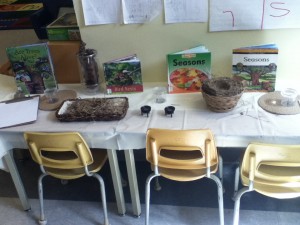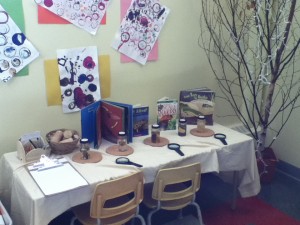Yesterday, one of our kindergarten students brought in a dinosaur made of scrap metal. He had received it as a gift over the weekend, and was so excited to show all of his friends at school. He brought it into the classroom in the morning and the children instantly began talking about dinosaurs. My teaching partner and I had them tidy up and meet us on the carpet. We allowed the student to tell us all about the dinosaur and then had a sharing time for all of the children to tell us what they wished to about dinosaurs. It amazed us how much they knew! We knew it was a wonderful opportunity to begin some inquiry based learning! We could sat on the carpet listening to the students for hours, but instead, we decided to quickly set up a few activities for them to actively share their knowledge instead. As the students were chatting on the carpet, and passing around the metal dinosaur, I set up the writing centre with pencil crayons, markers, pencils and writing paper so they could create stories with their knowledge. I also got out a large piece of mural paper so we could paint a scene where dinosaurs may have lived. In our book centre, I quickly gathered all of the dinosaur stories we had and put them in the centre of that carpet for the children to look at.
Later during the day, after nutrition break was finished, I set up some creative art centres for the students. I had printed pictures of dinosaurs for the children to do marble painting, set out toilet paper rolls for them to make 3D dinosaurs and put out construction paper/glue/scissors/markers for them to create their own dinosaurs. A small group of children also wanted to help finish the mural we had begun in the morning.
By the end of the day, we had created a dinosaur mural displaying our art, read 2 non-ficiton books about dinosaurs, hung several stories the children had created throughout the classroom and had time to share all of their knowledge that they already had about dinosaurs. The children were engaged in all of the centres throughout the day and are excited to continue to learn about dinosaurs.
 We are currently working on growth and change as an inquiry focus. I have selected materials that we have found in nature as well as some science items like worms, frogs, chicken embryos, and grasshoppers for the children to examine. We have studied some of them using our KWL chart—becoming researchers and looking in books, and on the internet to answer our “I wonder” questions. Through this learning process, children have been exposed to several types of non-fiction books (we compared fiction and non-fiction), learned how to journal their observations with adult support, and have drawn diagrams with labels. The materials are left for them to explore during our learning block of play. As children explore I will often place myself into the space to hear their conversations, to encourage them to record what they see, and to ask open-ended questions about their thoughts or to extend their learning. Next we will be adding our Butterflies to the collection!
We are currently working on growth and change as an inquiry focus. I have selected materials that we have found in nature as well as some science items like worms, frogs, chicken embryos, and grasshoppers for the children to examine. We have studied some of them using our KWL chart—becoming researchers and looking in books, and on the internet to answer our “I wonder” questions. Through this learning process, children have been exposed to several types of non-fiction books (we compared fiction and non-fiction), learned how to journal their observations with adult support, and have drawn diagrams with labels. The materials are left for them to explore during our learning block of play. As children explore I will often place myself into the space to hear their conversations, to encourage them to record what they see, and to ask open-ended questions about their thoughts or to extend their learning. Next we will be adding our Butterflies to the collection!
Here is a great, free resource entitled Natural Curiosity http://naturalcuriosity.ca/pdf/NaturalCuriosityManual.pdf
It gives details and research round building inquiry from nature and the world around children! The full website is http://naturalcuriosity.ca/
I have found a great book called: Beautiful Stuff Learning with found materials. It is a great resource to get a collection of found materials started in your classroom and a great springboard to spark an inquiry or 2.
My finding came at a great time! We have been working on the reading strategy, making connections and many of my students could not remember a birthday or have never experienced one so my ECE partner and I decided to create one. The students have been listening to Junie B. Jone stories all year so we wanted to have a birthday for our character. We planned and touched on all aspect of a birthday. The resource, Beautiful Stuff, became the ”gift” the children would bring to the party.
The book begins discussing what recycled materials would be useful to collect from children’s homes. Things like; paper, old jewellery, buttons, ribbons etc. They bring them to school in a bag for exploring in small or large group. The book explores the materials and shares the dialogue between teacher and students, tells about the sorting processing, and gives some great prompts to move the thinking and investigating along. Other chapters discuss building with wood pieces, collaging, and various other ideas that could extend what you can do with all the found materials.
Our Beautiful Stuff has lead us into a Building Inquiry, an Art Inquiry, we have used the items to extend into our Math Focus and Fine Motor for sorting. As well, building on oral language.
The found materials have now become my art centre. The children initially sorted all the materials into baskets, trays etc. Each day they can access the materials to create. I may add new items, give a lesson about something new they can do with the materials, I added more popsicle sticks and large cardboard on day, another day I added the paint. They tied it into our building inquiry.
Below are a few pictures of the children first exploring, then creating with the materials.
![IMG_3183[1]](https://earlylearningcentral.ca/wp-content/uploads/2013/04/IMG_31831-300x225.jpg) These children are showing what they have collected for the first time in small groups.
These children are showing what they have collected for the first time in small groups.
This child created a house using the real wood pieces. He is also drawing out the structure like an Architect. With adult assistance children are trying out real tools.
Below the children have creating pictures with the materials.
This is a great article from the Primarily Play Resource distributed by ETFO for K-3.
http://earlylearningcentral.ca/wp-content/uploads/2009/02/PP-pages-16-21.pdf
The article discusses some great points about neuroscience and how the brain needs to be “worked” and norished so that the brain can function later in life. Experience changes to brain. So, a teacher planning my classroom; assessments, centres, inquiry ideas we want to provoke thinking, plan robust questions, and meet the needs of each learning in our classroom. Learning in play is very social and is often far from a quiet place. Purposefully conversations about what the children are doing and learning; “hum of creativity and friendship is a sign of a happy learning environment” (p.3)
Some provoking questions to reflect on;
-Are there engaging opportunities for children to explore? Are they changed often?
-Are there areas for children to display there work? Is there a place to display the conversations and pictures (documentation board)? How do we celebrate learning?
When we see an area of development that is not being met, what do we do?
-Is the environment a safe place for children to learn without judgement?
-Are there strategies possibly around self-regulation that are implemented in the classroom?
-Are there resources (books), a character program (Social Justice Begins with Me) that can address and promote self-confidence, and promote positives?
An overall thought when looking at the whole classroom environment and the children we teach:
How does the classroom value the whole child–developmentally and socially?
TO PLAY IS TO LEARN……have a read and see if you could change one thing to support student learning.
I came a cross a great idea using found materials. You can collect and gather a variety of recycled objects from around your home or ask your students to bring in materials, but I just focused on collecting lids. I have collected various sizes, colours, and shapes. From the dollar store I purchased a large, shallow tray to gather all the objects and some circular cork boards for children to arrange their materials on. Choose a space in your room to house the materials or display them on a table–tray in the middle and cork boards around to create an inviting space. Allow children to create designs based on colour, shapes or other attributes and see where the discussion may go….
Picture to follow shortly….



![IMG_3416[1]](https://earlylearningcentral.ca/wp-content/uploads/2013/04/IMG_34161-300x225.jpg)
Recent Comments